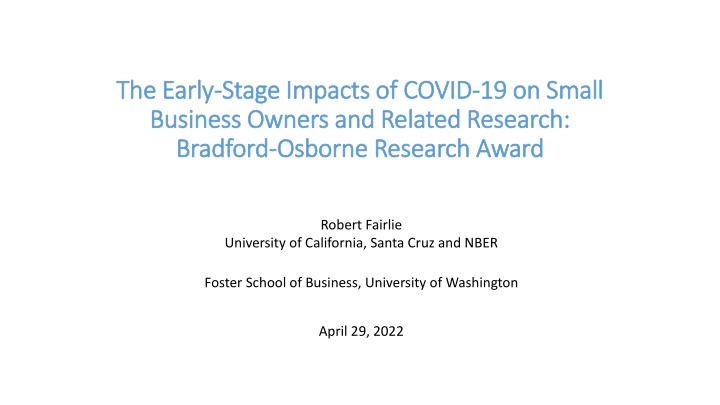
Early-Stage Impacts of COVID-19 on Small Business Owners and Research Insights
Discover the early effects of COVID-19 on small business owners and related research findings, including the disproportionate impacts on specific demographic groups. Explore data tracking active business owners during the pandemic and insights into the changes in the number of active business owners before and after COVID-19 restrictions.
Download Presentation

Please find below an Image/Link to download the presentation.
The content on the website is provided AS IS for your information and personal use only. It may not be sold, licensed, or shared on other websites without obtaining consent from the author. If you encounter any issues during the download, it is possible that the publisher has removed the file from their server.
You are allowed to download the files provided on this website for personal or commercial use, subject to the condition that they are used lawfully. All files are the property of their respective owners.
The content on the website is provided AS IS for your information and personal use only. It may not be sold, licensed, or shared on other websites without obtaining consent from the author.
E N D
Presentation Transcript
The Early The Early- -Stage Impacts of COVID Stage Impacts of COVID- -19 on Small Business Owners Business Owners and Related Research: and Related Research: Bradford Bradford- -Osborne Research Award Osborne Research Award 19 on Small Robert Fairlie University of California, Santa Cruz and NBER Foster School of Business, University of Washington April 29, 2022
The Early Impacts of COVID The Early Impacts of COVID- -19 19 Stores, factories and many other businesses closed by policy mandate, downward demand shifts, health concerns, or other factors. But the early effects of COVID-19 on small businesses were difficult to measure because of the lack of timely data, especially by race, ethnicity and gender How large were the early-stage impacts of COVID-19 and were there disproportionate impacts for specific demographic groups? Use Current Population Survey (CPS) microdata from the Bureau of Labor Statistics (BLS) to track active business owners in the pandemic
Timeline Timeline March 11, 2020: The World Health Organization (WHO) declared COVID-19 a pandemic. March 16, 2020: San Francisco Bay Area imposed shelter-in-place restrictions March 19, 2020: State of California March 20, 2020: New York State By early April: most states imposed social distancing restrictions
Figure 1 Number of Active Business Owners in the United States (January 2000 - April 2020) 18,000,000 16,000,000 14,000,000 12,000,000 April 2020 10,000,000 8,000,000 2005 2006 2007 2008 2009 2010 2011 2012 2013 2014 2015 2016 2017 2018 2019 2020
Figure 2: Number of Active Business Owners before and after COVID-19 18,000,000 16,000,000 14,000,000 Number of Self-Employed Business Owners 12,000,000 -22% 10,000,000 -28% 8,000,000 -31% 6,000,000 4,000,000 2,000,000 0 Worked in Survey Week Worked 15+ Hours Worked 30+ Hours Feb-20 Apr-20
Figure 2: Losses in the Number of Active Business Owners before and after COVID-19 Restrictions (February to April 2020) -41% African-American Latinx -32% -26% Asian -17% White
Figure 4: Number of Active Owners before and after COVID-19 (Gender) 10,000,000 9,000,000 8,000,000 Number of Self-Employed Business Owners (000s) 7,000,000 -20% 6,000,000 5,000,000 4,000,000 -25% 3,000,000 2,000,000 1,000,000 0 Female Male Feb-20 Apr-20
Figure 6: Number of Active Business Owners before and after COVID-19 (Immigrant Status) 12,000,000 10,000,000 Number of Self-Employed Business Owners (000s) -18% 8,000,000 6,000,000 4,000,000 2,000,000 -36% 0 Immigrant Native Feb-20 Apr-20
Industry Changes Industry Changes Feb. to April Industry Agriculture Construction Manufacturing Retail Trade Transportation Financial activities Professional and bus. Health services Arts, leisure, hotels Restaurants Repair and maintenance Personal and laundry serv. 926,409 Number 869,661 2,436,057 566,192 1,068,484 798,325 1,301,769 3,295,875 1,238,335 685,009 409,605 512,403 7% -27% -11% -10% -22% -12% -18% -16% -35% -22% -25% -79%
Simulations Predicted using Feb. to Apr. Actual Change Feb. to Apr. Group Total Female Male Black Latinx Asian White Immigrant Native -22% -25% -20% -41% -32% -26% -17% -36% -18% -22% -19% -23% -35% -28% -22% -18% -35% -19%
The COVID-19 pandemic has shed light to the disparities already facing minority-owned small businesses, said Harris. With over 40% of Black small businesses closed due to COVID-19, its imperative Congress ensure that we are doing everything we can to support and lift up these businesses, particularly during a health and economic pandemic.
Has There been a Rebound in Small Business Has There been a Rebound in Small Business Activity since April 2020? Activity since April 2020? Ongoing tracking of business ownership patterns based on requests by: President s Office Vice President s Office Senate and House Testimonies and Committees California State Assembly and Governor s Office Media
Figure 1: Number of Active Business Owners in the United States (Jan. 2019 - Dec. 2021) 18,000,000 16,000,000 October 2020 December 2021 14,000,000 February 2021 12,000,000 April 2020 10,000,000 8,000,000 2019 2019.25 2019.5 2019.75 2020 2020.25 2020.5 2020.75 2021 2021.25 2021.5 2021.75 2022
Figure 2: Number of Active Business Owners in the United States by Race 3,000,000 2,000,000 1,000,000 0 2019 2019.25 2019.5 2019.75 2020 2020.25 2020.5 2020.75 2021 2021.25 2021.5 2021.75 2022 Black Latinx Asian
Table 1.2Q: Quarterly Change in Number of Active Business Owners Black Latinx Relative to: 2020 Q1 100% Asian White Relative to: 2020 Q1 Relative to: 2020 Q1 100% Relative to: 2020 Q1 100% 2020 Q1 2020 Q2 2020 Q3 2020 Q4 2021 Q1 2021 Q2 2021 Q3 2021 Q4 100% 89% 100% 101% 97% 102% 105% 105% 69% 95% 99% 100% 110% 128% 109% 83% 100% 106% 97% 107% 119% 120% 82% 90% 83% 93% 102% 105% 105%
Follow Follow- -up Research Projects up Research Projects What happened to other small business outcomes in the pandemic? Permanent business closures Did new businesses arise out of necessity from job losses? What happened to business owner earnings? Paycheck Protection Program Were funds allocated proportionately to communities of color? Evolution of program over time? U.S. Senate
Permanent Small Business Closures Permanent Small Business Closures CPS: active business owners (temporary or permanent closures?) Surprisingly little is known on whether these shutdowns turned into permanent closures and whether small businesses were disproportionately hit. Difficult to measure permanent closures Create and analyze measure of permanent business closures using confidential administrative firm-level panel microdata Covers the universe of businesses filing sales taxes California Department of Tax and Fee Administration
8% Figure 4: Total Business Quarterly Closure Rate, 2015Q2 to 2020Q3 7% 6% 5% 4% 3% 2% 1% 0% 2015 2016 2017 2018 2019 2020 2021
16% Figure 5: Quarterly Closure Rates by Taxable Sales Size, 2015Q2 to 2020Q3 14% 12% 10% 8% 6% 4% 2% 0% 2015 2016 2017 2018 2019 2020 2021 Taxable Sales: 1 - 50k Taxable Sales: 50k - 100k Taxable Sales: 100k - 500k Taxable Sales: 500k - 1M Taxable Sales: 1M - 10M Taxable Sales: >=10M
40 Figure 7: Herfindahl-Hirschman Index for Taxable Sales, 2015Q1 to 2021Q3 35 30 25 20 15 10 2015 2016 2017 2018 2019 2020 2021 2022
What happened to small business owners in What happened to small business owners in the pandemic? the pandemic? Did new businesses arise out of necessity from job losses? Kauffman Early-Stage Entrepreneurship Indicators Opportunity Share What happened to business owner earnings? ASEC (March) CPS Files include calendar year earnings (2020) Project for the Small Business Administration
Figure 2 Opportunity Share of New Entrepreneurs (Annual) (1996-2020) 100.0% 95.0% 90.0% 85.0% 80.0% 75.0% 70.0% 65.0% 60.0% 55.0% 50.0% 199619971998199920002001200220032004200520062007200820092010201120122013201420152016201720182019202020212022 Source: Estimates calculated from the Current Population Survey.
Figure 5: Mean Log Business Earnings Trends, 2015-2020 10.80 10.70 10.60 10.50 10.40 10.30 10.20 10.10 10.00 9.90 9.80 2015 2016 2017 2018 2019 2020 2021 White Black Latinx Asian
Pandemic What happened to small business Pandemic What happened to small business owners in the pandemic? owners in the pandemic? Blinder-Oaxaca decompositions Explanations for difference between two groups at one point in time Pandemic interaction decomposition Provide an answer to the question, for example, of how much did the pre- pandemic Black industry distribution relative to the White distribution contribute to larger Black business earnings losses in the pandemic ? ?2019 )( ?2020 ?2019 ) ? (?2019
Table 7: Decompositions of Changes in Log Business Earnings Gaps Black-White 9.952 10.229 -0.277 10.361 10.510 -0.150 -0.127 Latinx-White 9.987 10.177 -0.191 10.361 10.510 -0.150 -0.041 Asian-White 10.437 10.645 -0.209 10.361 10.510 -0.150 -0.059 Minority log bus. income 2020 Minority log bus. income 2019 Minority loss White log bus. income 2020 White log bus. income 2019 White loss Minority Disproportionate Loss Contributions to disproportionate losses from 2019 racial differences in: Education -0.005 0.003 0.018 Industry -0.063 -0.021 -0.065 Region -0.009 -0.011 -0.013 Central City Status -0.011 -0.013 -0.013 Age 0.008 0.008 0.004 Female -0.001 0.001 -0.003 All included variables -0.082 -0.033 -0.071
Paycheck Protection Program Paycheck Protection Program Provided loans to small businesses that could be forgiven if employees were kept on the payroll through the pandemic Were funds allocated proportionately to communities of color? Evolution of program over time? Size and scope of program: Number of loans=11,823,594 Total net dollars=$799,832,866,520 Number of different lenders=5,467
Paycheck Protection Program Loans per Employer Establishment by Minority Share of Zip Code First Round (April 3-April 16, 2020) 0.18 0.16 0.14 0.12 0.1 0.08 0 0.05 0.1 0.15 0.2 0.25 0.3 0.35 0.4 0.45 0.5 0.55 0.6 0.65 0.7 0.75 0.8 0.85 0.9 0.95
Paycheck Protection Program Loans per Employer Establishment by Minority Share of Zip Code Second Round (April 27-August 8, 2020). First Round (April 3-April 16, 2020) 0.52 0.18 0.47 0.16 0.42 0.37 0.14 0.32 0.12 0.27 0.1 0.22 0.08 0.17 0 0.05 0.1 0.15 0.2 0.25 0.3 0.35 0.4 0.45 0.5 0.55 0.6 0.65 0.7 0.75 0.8 0.85 0.9 0.95 0 0.05 0.1 0.15 0.2 0.25 0.3 0.35 0.4 0.45 0.5 0.55 0.6 0.65 0.7 0.75 0.8 0.85 0.9 0.95
Paycheck Protection Program Loans per Employer Establishment by Minority Share of Zip Code Third Round (2021)
Summary Summary Business owners of color were disproportionately affected early in the pandemic But, strong rebound from early losses Other outcomes were affected: many permanent closures, necessity entrepreneurship increased, and business owner earnings fell PPP funds were slow in being distributed to minority communities But, 2021 (third round) aggressively targeted small businesses in those communities More research needed on long-term effects on inequality and PPP effectiveness
More Information More Information Research https://people.ucsc.edu/~rfairlie/papers/ Small Business Tracking https://people.ucsc.edu/~rfairlie/recent/ Government Testimony and Bills https://people.ucsc.edu/~rfairlie/government/
Figure 1: Quarterly Gross Domestic Product Growth Rate, 1947Q2 - 2020Q2 20 10 0 1945 1955 1965 1975 1985 1995 2005 2015 Quarterly GDP Growth Rate -10 -20 -30 -40






















